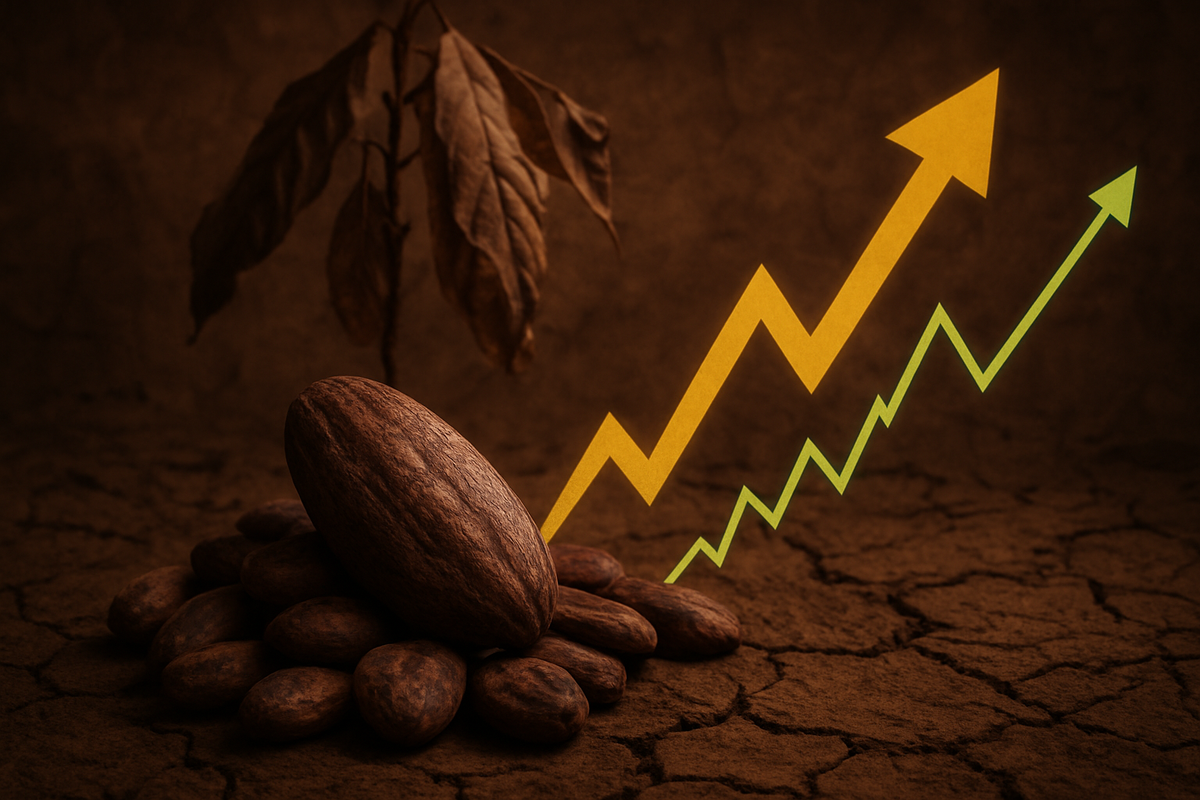
Cocoa futures are experiencing a significant surge, driven by a confluence of tightening supplies, robust institutional interest, and an impending inclusion in a major commodity index. This volatility is sending ripples through global financial markets and the confectionery industry, signaling a sustained period of elevated chocolate prices for consumers worldwide. The recent upward trajectory, marked by cocoa futures climbing to over $6,198 per ton on November 3, 2025, reflects deep-seated supply issues and a strategic shift in investment patterns, promising continued uncertainty for stakeholders.
The immediate implications are profound: chocolate manufacturers are grappling with unprecedented input costs, leading to further price hikes for consumers and a noticeable decline in sales volumes as demand destruction sets in. With the market bracing for substantial inflows from passive funds due to cocoa's upcoming inclusion in the Bloomberg Commodity Index, the stage is set for continued price amplification and a challenging environment for hedging strategies, forcing companies to re-evaluate their risk management approaches.
Unpacking the Surge: A Confluence of Factors
The recent jump in cocoa futures is the culmination of several critical factors. On November 1, 2025, December ICE NY cocoa (CCZ25) closed up 93 points (+1.54%), while December ICE London cocoa #7 (CAZ25) rose 84 points (+1.94%). This momentum continued into November 3, with prices climbing 0.8% in New York to $6,198 per ton, reaching levels not seen since late October. While prices had briefly dipped from a three-week peak of nearly $6,340 on October 23, the overall trend remains upward, with cocoa gaining 2.95% over the past four weeks. However, it's important to note the extreme volatility, as prices had previously soared to over $11,000 per metric ton earlier in 2025 and an all-time high of $12,906 in December 2024, only to plunge below $8,000/tonne through much of 2025 before this latest rally.
A primary catalyst for the current market excitement is the impending inclusion of cocoa in the Bloomberg Commodity Index (BCOM) starting in January. This marks cocoa's return to the index after two decades and is projected to funnel approximately $1.9 billion in passive fund investments into the market over the next 80 days. This institutional influx is expected to significantly boost trading volumes and further amplify price movements.
Beyond speculative interest, fundamental supply shortages are a dominant theme. ICE cocoa inventories in US ports have dwindled to a seven-month low, signaling a tight market. Ivory Coast, the world's largest cocoa producer, reported a 24% year-on-year decrease in exports for October 1-26, 2025. Nigeria, the fifth-largest producer, anticipates an 11% decline in cocoa production for the 2025/26 season. The International Cocoa Organization (ICCO) has revised its 2023/24 global cocoa deficit to a staggering 494,000 metric tons—the largest in over 60 years—with the global stocks-to-grindings ratio falling to a 46-year low of 27.0%.
The timeline of events highlights a deepening crisis. Extreme weather patterns and the pervasive spread of swollen shoot disease in West Africa, responsible for over 60% of global cocoa production, have severely hampered harvest volumes for multiple years. In October, top producers Côte d'Ivoire and Ghana responded by granting significant increases in farmgate prices by 56% and 12% respectively. While intended to support farmers, these increases raise the minimum price for cocoa buyers, further unsettling markets. Additionally, the British pound's recent drop to a 6.5-month low has contributed to higher London cocoa prices, as the commodity is priced in sterling.
Initial market reactions reflect a scramble for stability. Large food companies are finding traditional hedging strategies challenging due to the unusual inversion of the futures market, where near-term contracts are more expensive than distant ones. This has led some to reduce their reliance on futures contracts for risk management, opting for alternative strategies or simply absorbing higher costs.
Corporate Fortunes: Winners and Losers in a Volatile Market
The tumultuous cocoa market is creating a clear divide between potential winners and losers among public companies. Chocolate manufacturers, heavily reliant on cocoa as a primary ingredient, are facing significant headwinds. Companies like Mondelez International (NASDAQ: MDLZ) and The Hershey Company (NYSE: HSY) are at the forefront of this challenge. Mondelez, for instance, has projected a 10% reduction in adjusted earnings per share in 2025 due to cocoa market instability. Hershey, while reporting strong sales, has seen its margins plummet amid surging cocoa inflation. These companies are forced to either absorb higher costs, which erodes profitability, or pass them on to consumers, risking demand destruction.
The strategy of passing on costs is already evident, with retail chocolate prices in major markets having risen by 15-25% since early 2024, and further increases anticipated. This has led to a noticeable decline in sales volumes; North American chocolate candy sales volumes were down over 21% in the 13 weeks ending October 5, even as the average price per pound surged by nearly 14%. Consumers are responding by reducing chocolate spending, opting for different brands, smaller sizes, or shifting to non-chocolate treats like sour gummies. This "demand destruction" directly impacts the revenue and market share of major confectionery players.
On the other hand, cocoa producers and traders, particularly those with existing stockpiles or robust supply chain management, stand to benefit from the elevated prices. While the underlying issues of disease and climate change are long-term concerns, in the short to medium term, firms involved in the physical trading and distribution of cocoa could see increased revenues. However, the benefits are not uniform, as the farmgate price increases, while helping farmers, squeeze the margins of intermediaries who purchase from them. Companies involved in sustainable sourcing initiatives and direct trade relationships might also gain a competitive advantage by securing more stable supplies in a volatile market.
Furthermore, agricultural technology companies offering solutions for disease resistance, yield improvement, or sustainable farming practices in cocoa-producing regions could see increased demand for their services and products. As the industry grapples with chronic supply issues, investment in these areas becomes critical, potentially creating new opportunities for innovation and growth for companies operating in the agritech space.
Broader Implications and Historical Parallels
The current cocoa crisis is not an isolated event but rather a stark indicator of broader industry trends and vulnerabilities within global agricultural supply chains. The multi-year global cocoa deficit underscores the growing impact of climate change, disease, and unsustainable farming practices on essential commodities. This situation highlights the critical need for diversified sourcing, robust sustainability initiatives, and significant investment in agricultural resilience, especially in regions highly susceptible to environmental shocks.
The ripple effects extend beyond the chocolate industry. Competitors in the broader confectionery market, particularly those offering non-chocolate alternatives, stand to gain as consumers shift preferences due to rising chocolate prices. Companies specializing in ingredients that can substitute or extend cocoa, or those offering alternative indulgence products, might see an uptick in demand. Partners in the supply chain, such as logistics and processing companies, face increased operational costs and the challenge of managing highly volatile inventory values.
Regulatory and policy implications are also emerging. The significant farmgate price increases in Côte d'Ivoire and Ghana reflect a growing recognition of the need to support cocoa farmers, who have historically received a small fraction of the final product's value. This trend could lead to greater scrutiny of supply chain ethics and potentially more stringent regulations regarding fair trade and farmer compensation across the industry. Governments in producing nations may also explore policies to incentivize sustainable farming and combat disease, possibly through international aid or industry partnerships.
Historically, commodity markets have experienced boom-bust cycles, and cocoa is no stranger to such volatility. The current surge, while driven by unique factors, echoes past periods of scarcity-induced price spikes. For instance, similar patterns have been observed in coffee or sugar markets when adverse weather or geopolitical events disrupt supply. The unprecedented deficit and the rapid price ascent draw parallels to the early 1970s cocoa boom, though the underlying drivers (then primarily political instability and demand growth, now supply shocks and climate) differ. These historical precedents suggest that while current prices are high, they may incentivize increased planting and investment in production, potentially leading to an oversupply in 3-5 years when new trees mature, thereby completing a cycle of price correction.
Navigating the Future: Short-Term Challenges and Long-Term Shifts
Looking ahead, the cocoa market is poised for continued volatility in the short term. The substantial influx of capital from passive funds tracking the Bloomberg Commodity Index starting in January will likely provide further upward pressure on prices and amplify market movements. Chocolate manufacturers face the immediate challenge of managing these elevated input costs, which will necessitate ongoing price adjustments for consumers and a continued focus on efficiency and cost-cutting measures within their operations. Companies will need to be agile in their supply chain management, potentially exploring new sourcing regions or strengthening direct relationships with farmer cooperatives to secure supply.
In the long term, the current crisis is expected to accelerate strategic pivots across the industry. We can anticipate increased investment in research and development to create more disease-resistant cocoa varieties and improve agricultural yields. Sustainability initiatives will gain even greater prominence, not just as a corporate social responsibility but as a critical business imperative for securing future supply. This includes efforts to combat deforestation, promote shade-grown cocoa, and implement climate-smart agricultural practices. Companies that can demonstrate a robust and sustainable supply chain will gain a significant competitive advantage.
Market opportunities may emerge for innovative companies offering alternative ingredients or processing technologies that can reduce reliance on traditional cocoa. Furthermore, the high prices could stimulate investment in new cocoa-producing regions outside of West Africa, diversifying the global supply base over the next decade. However, these opportunities come with significant challenges, including the long lead time for new cocoa trees to mature and the need for substantial capital investment in infrastructure and farmer training.
Potential scenarios range from a sustained period of high prices if supply issues persist and demand remains relatively inelastic, to a gradual stabilization if new production comes online and demand destruction significantly reduces consumption. A more extreme scenario could see a sharp correction if speculative interest wanes or if a surprisingly strong harvest materializes, though the latter seems less likely given current projections. The most probable outcome is a protracted period of elevated prices and market uncertainty, punctuated by significant price swings, as the industry adapts to a new normal of constrained supply and evolving consumer behavior.
A New Era for Cocoa: Key Takeaways and Investor Watchpoints
The current surge in cocoa futures marks a pivotal moment, signaling a new era for the global cocoa and chocolate industry. The key takeaway is the profound impact of supply-side constraints—driven by climate change, disease, and underinvestment in farming—amplified by significant institutional interest. This combination has created an unprecedented market environment characterized by extreme volatility and sustained high prices. The market moving forward will be defined by a relentless focus on securing supply, managing costs, and adapting to shifting consumer demands.
For investors, the coming months will require careful observation of several critical factors. Firstly, monitor the actual capital inflows into cocoa futures following its inclusion in the Bloomberg Commodity Index in January; the scale of this investment will dictate much of the short-term price action. Secondly, keep a close eye on harvest reports from West Africa and other key producing regions; any unexpected improvements or deteriorations in yield will have an immediate impact. Thirdly, track consumer behavior and sales volumes of chocolate products; continued demand destruction will pressure chocolate manufacturers and could eventually lead to price adjustments.
Finally, pay attention to the strategic responses of major chocolate companies like Mondelez International (NASDAQ: MDLZ), The Hershey Company (NYSE: HSY), and Nestlé S.A. (SWX: NESN). Their long-term investments in sustainable sourcing, agricultural R&D, and product innovation will be crucial indicators of the industry's ability to adapt and thrive in this challenging new landscape. The lasting impact of this event will likely be a more expensive, more sustainably sourced, and potentially more diversified cocoa market, fundamentally reshaping the global chocolate industry for years to come.
This content is intended for informational purposes only and is not financial advice



